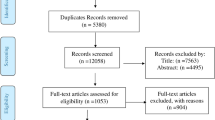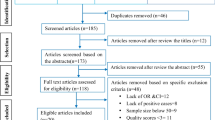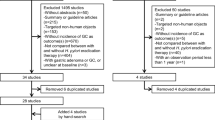Abstract
Background and aims
Recent studies have demonstrated the relationship between Helicobacter pylori infection and the risk of colorectal carcinoma. However, the results of these studies remain controversial as the studies were relatively small in size and partially differed in designs, and so we reviewed the published studies and carried out a meta-analysis to further explore this relationship.
Materials and methods
We performed an extensive systematic review to find all the published case–control studies up to Jan. 2007 using electronic searching, hand searching, and reference lists of retrieved articles. Odds ratio (OR) was employed to evaluate the relationship of H. pylori infection and risk of colorectal cancer. Summary estimates were obtained using random effect models according to the result of a statistical test for heterogeneity across the studies. The presence of possible publication bias was assessed using different statistical approaches.
Results
Thirteen studies were included, and summary OR 1.49 (95% confidence interval [CI] 1.17–1.91) was estimated for the association between H. pylori infection and colorectal cancer. Summary OR 1.56 (95% CI 1.14–2.14) was estimated for the association between immunoglobulin G antibody and colorectal cancer risk. By trimming and filling, the number of inputted studies was zero, and summary OR was still 1.49 (95% CI 1.17–1.91). The graphical funnel plot appeared asymmetrical, but there was no statistical evidence of publication bias. The method of fail-safe suggested that the effect of publication bias was small.
Conclusion
Current evidence, though limited, suggests that there is a possible increase in risk of colorectal cancer because of H. pylori infection.




Similar content being viewed by others
References
Remontet L, Esteve J, Bouvier AM, Grosclaude P, Launoy G, Menegoz F, Exbrayat C, Tretare B, Carli PM, Guizard AV, Troussard X, Bercelli P et al (2003) Cancer incidence and mortality in France over the period 1978–2000. Rev Epidemiol Sante Publique 51:3–30
Yiu HY, Whittemore AS, Shibata A (2004) Increasing colorectal cancer incidence rates in Japan. Int J Cancer 109:777–781
From: American Cancer Society: Cancer Facts and Figures (2006) Atlanta, Ga: American Cancer Society, 2006. Also available online. Last accessed October 10, 2006
Sun XW, Wu SL, Lin YJ, Bo W, Han HL, Dai XD (2004) Trend of morbidity and mortality of colorectal carcinoma in Nangang District of Harbin from 1992 to 2001. World Chin J Digestol 12:2302–2306
Gustin DM, Brenner DE (2002) Chemoprevention of colon cancer: current status and future prospects. Cancer Metastasis Rev 21:323–348
Giovannucci E, Colditz GA, Stampfer MJ, Hunter D, Rosner BA, Willett WC, Speizer FE (1994) A prospective study of cigarette smoking and risk of colorectal adenoma and colorectal cancer in U.S. women. J Natl Cancer Inst 86:192–199
Potter JD, Slattery ML, Bostick RM, Gapstur SM (1993) Colon cancer: a review of the epidemiology. Epidemiol Rev 15:499–545
Cho E, Smith-Warner SA, Ritz J, van den Brandt PA, Colditz GA, Folsom AR, Freudenheim JL, Giovannucci E, Goldbohm RA, Graham S, Holmberg L, Kim DH et al (2004) Alcohol intake and colorectal cancer: a pooled analysis of 8 cohort studies. Ann Intern Med 140:603–613
Astorg P, Boutron-Ruault MC, Andrieux C, Astorg P, Blachier F, Blottiere H, Bonithon-Kopp C, Boutron-Ruault MC, Cassand P, Chaumontet C, Cherbut C, Clavel-Chapelon F et al (2002) Dietary fibers and colorectal cancer. Experimental studies, epidemiology, mechanisms. Gastroenterol Clin Biol 26:893–912
Papadopoulos N, Lindblom A (1997) Molecular basis of HNPCC: mutations of MMR genes. Hum Mutat 10:89–99
Liu B, Parsons R, Papadopoulos N, Nicolaides NC, Lynch HT, Watson P, Jass JR, Dunlop M, Wyllie A, Peltomaki P, de la Chapelle A, Hamilton SR et al (1996) Analysis of mismatch repair genes in hereditary non-polyposis colorectal cancer patients. Nat Med 2:169–174
Whitehouse A, Meredith DM, Markham AF (1998) DNA mismatch repair genes and their association with colorectal cancer. Int J Mol Med 1:469–474 Review
Penman ID, el-Omar E, Ardill JE, McGregor JR, Galloway DJ, O'Dwyer PJ, McColl KE (1994) Plasma gastrin concentrations are normal in patients with colorectal neoplasia and unaltered following tumor resection. Gastroenterology 106:1263–1270
Fireman Z, Trost L, Kopelman Y, Segal A, Sternberg A (2000) Helicobacter pylori: seroprevalence and colorectal cancer. Isr Med Assoc J 2:6–9
Hartwich A, Konturek SJ, Pierzchalski P, Zuchowicz M, Labza H, Konturek PC, Karczewska E, Bielanski W, Marlicz K, Starzynska T, Lawniczak M, Hahn EG (2001) Helicobacter pylori infection, gastrin, cyclooxygenase-2, and apoptosis in colorectal cancer. Int J Colorectal Dis 16:202–210
Limburg PJ, Stolzenberg-Solomon RZ, Colbert LH, Perez-Perez GI, Blaser MJ, Taylor PR, Virtamo J, Albanes D (2002) Helicobacter pylori seropositivity and colorectal cancer risk: a prospective study of male smokers. Cancer Epidemiol Biomark Prev 11:1095–1099
Infection with Helicobacter pylori. IARC Monogr Eval Carcinog Risks Hum 1994; 61:177–240
Suzuki T, Matsuo K, Ito H, Hirose K, Wakai K, Saito T, Sato S, Morishima Y, Nakamura S, Ueda R, Tajima K (2006) A past history of gastric ulcers and Helicobacter pylori infection increase the risk of gastric malignant lymphoma. Carcinogenesis 27:1391–1397
Isaacson PG, Du MQ (2004) MALT lymphoma: from morphology to molecules. Nat Rev Cancer 4:644–653
Parsonnet J, Isaacson PG (2004) Bacterial infection and MALT lymphoma. N Engl J Med 350:213–215
Konturek SJ, Konturek PC, Hartwich A, Hahn EG (2000) Helicobacter pylori infection and gastrin and cyclooxygenase expression in gastric and colorectal malignancies. Regulatory Pept 93:13–19
Hartwich J, Konturek SJ, Pierzchalski P, Zuchowicz M, Konturek PC, Bielanski W, Marlicz K, Starzynska T, Lawniczak M (2001) Molecular basis of colorectal cancer—role of gastrin and cyclooxygenase-2. Med Sci Monit 7:1171–181
Stoicov C, Saffari R, Cai X, Hasyagar C, Houghton J (2004) Molecular biology of gastric cancer: Helicobacter infection and gastric adenocarcinoma: bacterial and host factors responsible for altered growth signaling. Gene 341:1–17
Higgins JP, Thompson SG, Deeks JJ, Altman DG (2003) Measuring inconsistency in meta-analyses. BMJ 327:557–560
Copas J, Shi JQ (2000) Meta-analysis, funnel plots and sensitivity analysis. Biostatistics 1:247–262
Schork MA (2003) Publication bias and meta analysis. J Hypertens 21:243–245
Duval S, Tweedie R (2000) Trim and fill: a simple funnel-plot-based method of testing and adjusting for publication bias in meta-analysis. Biometrics 56:455–463
Song F, Khan KS, Dinnes J, Sutton AJ (2002) Asymmetric funnel plots and publication bias in meta-analyses of diagnostic accuracy. Int J Epidemiol 31:88–95
Sterne JA, Egger M, Smith GD (2001) Systematic reviews in health care: investigating and dealing with publication and other biases in meta-analysis. BMJ 323:101–105
Thorburn CM, Friedman GD, Dickinson CJ, Vogelman JH, Orentreich N, Parsonnet J (1998) Gastrin and colorectal cancer: a prospective study. Gastroenterology 115:275–280
Talley NJ, Zinsmeister AR, Weaver A, DiMagno EP, Carpenter HA, Perez-Perez GI, Blaser MJ (1991) Gastric adenocarcinoma and Helicobacter pylori infection. J Natl Cancer Inst 83:1734–1739
Shmuely H, Passaro D, Figer A, Niv Y, Pitlik S, Samra Z, Koren R, Yahav J (2001) Relationship between Helicobacter pylori CagA status and colorectal cancer. Am J Gastroenterol 96:3406–3410
Breuer-Katschinski B, Nemes K, Marr A, Rump B, Leiendecker B, Breuer N, Goebell H, Colorectal Adenoma Study Group (1999) Helicobacter pylori and the risk of colonic adenomas. Digestion 60:210–215
Williams MP, Pounder RE (1999) Helicobacter pylori: from the benign to the malignant. Am J Gastroenterol 94:S11–S116
Marshall B (2002) Helicobacter pylori: 20 years on. Clinical Medicine (London, England) 2:147–152
Pinto-Santini D, Salama NR (2005) The biology of Helicobacter pylori infection, a major risk factor for gastric adenocarcinoma. Cancer Epidemiol Biomark Prev 14:1853–1858
Zumkeller N, Brenner H, Zwahlen M, Rothenbacher D (2006) Helicobacter pylori infection and colorectal cancer risk: a meta-analysis. Helicobacter 11:75–80
Inoue F, Chiba T (1999) Regression of MALT lymphoma of the rectum after anti-H. pylori therapy in a patient negative for H. pylori. Gastroenterology 117:514–515
Matsumoto T, Iida M, Shimizu M (1997) Regression of mucosa-associated lymphoid-tissue lymphoma of rectum after eradication of Helicobacter pylori. Lancet 350:115–116
Raderer M, Pfeffel F, Pohl G, Mannhalter C, Valencak J, Chott A (2000) Regression of colonic low grade B cell lymphoma of the mucosa associated lymphoid tissue type after eradication of Helicobacter pylori. Gut 46:133–135
Hori K, Suguro M, Koizuka H, Sakagami T, Tomita T, Kosaka T, Fukuda Y (2004) Disappearance of rectal mucosa-associated lymphoid tissue lymphoma following antibiotic therapy. Dig Dis Sci 49:413–416
Meucci G, Tatarella M, Vecchi M, Ranzi ML, Biguzzi E, Beccari G, Clerici E, de Franchis R (1997) High prevalence of Helicobacter pylori infection in patients with colonic adenomas and carcinomas. J Clin Gastroenterol 25:605–607
van de Wouw BA, de Boer WA, Hermsen HW, Valkenburg JG, Geuskens LM, Tytgat GN (1997) Usefulness of the 14C urea breath test as a semi-quantitative monitoring instrument after therapy for Helicobacter pylori infection. Scand J Gastroenterol 32:112–117
Kosunen TU, Seppala K, Sarna S, Sipponen P (1992) Diagnostic value of decreasing IgG, IgA, and IgM antibody titres after eradication of Helicobacter pylori. Lancet 339:893–895
Harris DM, Go VL (2004) Vitamin D and colon carcinogenesis. J Nutr 134:3463S–3471S
Doria-Rose VP, Newcomb PA, Morimoto LM, Hampton JM, Trentham-Dietz A (2006) Body mass index and the risk of death following the diagnosis of colorectal cancer in postmenopausal women (United States). Cancer Causes Control 17:63–70
Wei EK, Giovannucci E, Selhub J, Fuchs CS, Hankinson SE, Ma J (2005) Plasma vitamin B6 and the risk of colorectal cancer and adenoma in women. J Natl Cancer Inst 97:684–692
Longnecker MP, Chen MJ, Probst-Hensch NM, Harper JM, Lee ER, Frankl HD, Haile RW (1996) Alcohol and smoking in relation to the prevalence of adenomatous colorectal polyps detected at sigmoidoscopy. Epidemiology 7:275–280
Kuepper-Nybelen J, Rothenbacher D, Brenner H (2005) Relationship between lifetime alcohol consumption and Helicobacter pylori infection. Ann Epidemiol 15:607–613
Cardenas VM, Graham DY (2005) Smoking and Helicobacter pylori infection in a sample of U.S. adults. Epidemiology 16:586–590
Siddheshwar RK, Muhammad KB, Gray JC, Kelly SB (2001) Seroprevalence of Helicobacter pylori in patients with colorectal polyps and colorectal carcinoma. Am J Gastroenterol 96:84–88
Moss SF, Neugut AI, Garbowski GC, Wang S, Treat MR, Forde KA (1995) Helicobacter pylori seroprevalence and colorectal neoplasia: evidence against an association. J Natl Cancer Inst 87:762–733
Mizuno S, Morita Y, Inui T, Asakawa A, Ueno N, Ando T, Kato H, Uchida M, Yoshikawa T, Inui A (2005) Helicobacter pylori infection is associated with colon adenomatous polyps detected by high-resolution colonoscopy. Int J Cancer 117:1058–1059
Fujimori S, Kishida T, Kobayashi T, Sekita Y, Seo T, Nagata K, Tatsuguchi A, Gudis K, Yokoi K, Tanaka N, Yamashita K, Tajiri T et al (2005) Helicobacter pylori infection increases the risk of colorectal adenoma and adenocarcinoma, especially in women. J Gastroenterol 40:887–893
Author information
Authors and Affiliations
Corresponding author
Additional information
This study was supported by grants from the National Natural Foundation (2004–2006 No. 30371243).
Rights and permissions
About this article
Cite this article
Zhao, Ys., Wang, F., Chang, D. et al. Meta-analysis of different test indicators: Helicobacter pylori infection and the risk of colorectal cancer. Int J Colorectal Dis 23, 875–882 (2008). https://doi.org/10.1007/s00384-008-0479-z
Accepted:
Published:
Issue Date:
DOI: https://doi.org/10.1007/s00384-008-0479-z




